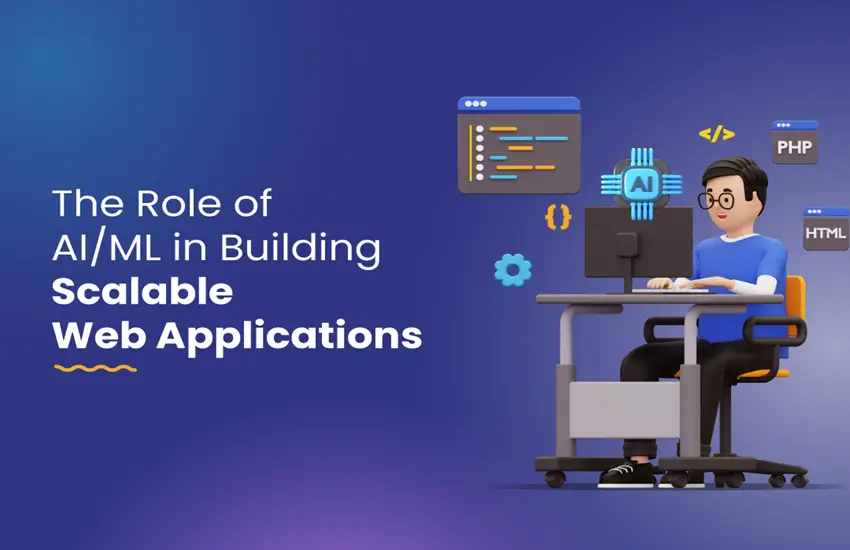
The Role of AI/ML in Building Scalable Web Applications
Imagine a web application that not only handles millions of users but also learns, adapts, and improves over time. Sounds futuristic? That’s the power of AI/ML in web development. They transform how developers create scalable web applications that are intelligent, efficient, and built to evolve.
From automating complex processes to delivering highly personalized user experiences, AI/ML for web apps helps developers solve challenges that once seemed daunting. Whether optimizing performance, predicting user needs, or analyzing data in real-time, AI/ML is reshaping how web applications are built and scaled. Eager to know in detail? Read on.
What Makes a Web Application Scalable?
In web development, scalability refers to a web application’s ability to handle increasing traffic, data, or users without compromising performance. A scalable web application can grow with demand while maintaining speed, reliability, and functionality.
Here are the key factors that contribute to web applications’ scalability.
-
Performance
The application should deliver fast response times even during peak usage.
-
Optimized Code
Efficient database queries and caching are essential to enhance performance.
-
Resource Optimization
Efficient use of server resources like CPU, memory, and storage ensures the application can run smoothly without overloading the system.
-
Load Handling
A scalable web application can balance incoming traffic across servers, adapt to spikes, and avoid crashes. This is achieved through techniques like load balancing and auto-scaling.
By focusing on these factors, developers can build scalable web applications that grow with user demand and offer a great experience to users.
How Does AI/ML Enhance Web Applications’ Scalability
AI/ML helps web applications become more scalable by automating and improving how they handle traffic, resources, and growth. It allows web apps to adjust in real-time, keeping everything running smoothly even during busy times.
Here’s how AI/ML for web apps makes a difference:
-
Predicting Demand:
AI analyzes historical traffic and usage data to predict when user demand will increase. By identifying patterns, AI enables the application to allocate resources in advance. It helps avoid slowdowns or crashes during peak times. This proactive approach ensures smooth performance and better user satisfaction.
-
Efficient Load Balancing:
Machine learning algorithms automatically distribute user requests across multiple servers. This reduces the strain on any single server, ensures consistent performance, and minimizes downtime. Load balancing powered by AI adapts to changes in traffic instantly, making it ideal for dynamic web environments.
-
Optimizing Resources:
AI monitors how the app uses CPU, memory, and storage resources. It ensures that resources are used efficiently, preventing overuse or underuse. By reducing waste, AI helps cut costs and maintain optimal performance, making the application more sustainable.
-
Adapting to Growth:
As the application’s user base grows, AI automatically detects when additional resources are needed and scales them up. This eliminates manual intervention, making it easier to manage growth and maintain a seamless user experience.
Key Applications of AI/ML in Building Scalable Web Apps
AI is changing how web applications are built and managed, especially when handling growth and ensuring smooth performance. Integrating AI in web development allows developers to build smarter applications to fulfill user needs and scale effectively. Here are some of the key applications:
-
Predictive Analytics for Traffic Management
Analyzing past traffic trends and user behavior, AI can predict when your application will experience a spike in demand. For example, it may notice a pattern of increased traffic during sales or holidays. Using this insight, AI can suggest relocating resources in advance to handle the extra load. This helps prevent crashes and ensures the app remains fast and responsive during peak times.
-
Efficient Load Balancing
Machine learning algorithms help distribute incoming user requests across servers in real-time. This prevents any single server from becoming overloaded and improves overall app performance. AI-powered load balancing can also adapt to changing traffic patterns, ensuring a consistent user experience, even during unexpected surges in demand.
-
Personalized User Experiences
AI tailors the application to meet user needs by analyzing their behavior, preferences, and interactions. For example, it can recommend products, customize dashboards, or adjust content based on user history. This personalization enhances user engagement and optimizes the app’s performance by delivering relevant content efficiently, even as the user base grows.
-
Database Optimization
AI is key in managing databases by automating tasks like indexing, optimizing queries, and caching frequently accessed data. It reduces latency and ensures the application can handle large volumes of data without slowing down. This is important for scalable apps that rely on fast and efficient data management.
-
Anomaly Detection and Issue Resolution
AI continuously monitors the application’s performance and looks for unusual patterns, such as slow response times or system errors. When it detects an issue, it can either resolve it automatically or alert the team to take action. This proactive approach ensures the app stays stable and minimizes downtime, even as it scales.
With futuristic AI/ML development, developers can build scalable, efficient, and user-friendly web applications that meet the demands of a growing user base.
AI/ML Tools and Technologies for Scalable Web Applications
Developers need the right tools and technologies to build scalable web applications with AI/ML. Here’s an overview of the top tools and technologies to consider:
Popular AI/ML Frameworks
- TensorFlow: A widely used open-source framework by Google that helps developers build and train machine learning models. It handles tasks like image recognition, natural language processing, and predictive analytics.
- PyTorch: Known for its simplicity and flexibility, PyTorch is a popular framework for developing and testing machine learning models. It is useful for deep learning applications.
- Scikit-learn: This lightweight library is ideal for implementing basic AI/ML algorithms like classification, regression, and clustering. It’s beginner-friendly and integrates well with other Python tools.
Tools for Real-Time Analytics
- Apache Kafka: Kafka is a powerful tool for managing real-time data streams. It’s often used in applications where data needs to be processed instantly, such as live dashboards or real-time notifications.
- Spark MLlib: This is a machine learning library for Apache Spark, designed for processing large-scale data quickly. It supports clustering, classification, and other algorithms, making it perfect for applications that analyze big data in real-time.
Cloud Services with Integrated AI/ML Features
- AWS (Amazon Web Services): AWS offers tools like SageMaker, which simplifies the process of building, training, and deploying machine learning models. It’s great for scalable AI/ML applications.
- Google Cloud: Google Cloud provides AI/ML tools like AutoML and TensorFlow Extended. These tools are designed to make AI accessible and scalable for developers.
- Azure: Microsoft Azure offers services like Azure Machine Learning, which provides end-to-end solutions for building and deploying AI models in scalable web applications.
With these tools and technologies, developers can use the power of AI and ML in web development to create scalable, efficient, and intelligent web applications.
Challenges of Using AI/ML in Web Applications
While AI/ML offers incredible benefits, implementing them in web applications is not free from challenges. Developers should look at these issues to ensure effective and sustainable solutions. Here are some common challenges:
-
Complexity in Implementing AI/ML Solutions
AI/ML solutions can be difficult to set up and integrate into web applications. Developers need expertise in data processing, model training, and deployment. They may lack the required expertise if they are new to AI/ML. Also, the complexity increases when building scalable web applications that handle growing user demands.
-
Resource-Intensive Training and Inference Processes
Training AI models often requires computational power, memory, and time. Even after deployment, running these models (inference) can consume many server resources, especially in real-time applications. This can impact the application’s overall performance, adding to the workload in web application development.
-
Managing Cost and Scalability
AI/ML models can be expensive to develop, deploy, and maintain. Scaling these models with the web application to handle more traffic increases costs and complexity. Developers should find ways to balance scalability without overspending on infrastructure and resources.
Despite these challenges, developers can integrate AI/ML into web applications with proper planning, tools, and expertise, ensuring long-term success and scalability.
Best Practices for Integrating AI/ML in Scalable Applications
Integrating AI/ML into scalable applications is no longer a luxury – it’s a necessity. This is why top business leaders are using AI to drive innovation and growth. If you are also planning the same, follow these practices:
-
Identify Critical Areas for AI/ML
You can start by identifying the key areas in your application where AI/ML can provide the most value. For example, use AI to personalize user experiences, predict user behavior, or automate repetitive tasks. Focusing on these high-impact areas ensures that AI/ML efforts deliver tangible results.
-
Use Pre-trained Models and APIs
Developing AI/ML models from scratch can be time-consuming. Instead, use pre-trained models and APIs to handle common tasks like natural language processing or image recognition. These tools reduce development time and allow you to focus on integrating the models into your application.
-
Monitor and Refine Models Regularly
AI/ML models need regular updates to maintain their effectiveness. Monitor performance, retrain models with updated data, and adjust them as necessary to ensure they continue to provide value as your application scales.
-
Use Cloud-Based AI/ML Services
Cloud-based AI/ML platforms like AWS SageMaker, Google AutoML, or Azure Machine Learning simplify scaling applications. These services manage resource allocation, training, and deployment, offering flexibility and cost-efficiency.
By following these best practices, you can successfully integrate AI/ML into your applications and build scalable systems that grow with demand.
Future of AI/ML in Scalable Web Applications
The future of AI/ML in scalable web applications looks exciting. Emerging technologies like Federated Learning and Edge AI are set to change how web apps work. Here is what the future looks like –
-
Federated Learning for Better Privacy
Federated learning allows AI models to be trained across multiple devices without sharing sensitive data. This helps protect user privacy and improves the application’s performance. It also reduces delays as data is processed locally, making web applications more secure and scalable.
-
Edge AI for Faster Processing
Edge AI brings AI processing closer to the user by running tasks on devices like smartphones or local servers instead of relying on the cloud. This means faster responses and better performance. For scalable web apps, Edge AI allows real-time decisions without overloading central systems.
-
Self-Optimizing AI Models
Future AI models will be able to monitor and improve themselves automatically. They will adapt to changes, fix performance issues, and stay efficient as the application grows. It reduces the need for constant manual updates.
-
Integration with IoT and Smart Devices
As more devices connect to the internet, web apps must handle large amounts of data from IoT devices. AI/ML will make it possible to process this data efficiently, ensuring the application stays scalable and responsive.
-
Smarter Automation
AI will continue to improve automation in web apps, handling workflows, managing resources, and adapting to user needs. This will make scaling applications simpler and more effective.
The future of AI/ML in web applications will focus on making them faster, smarter, and easier to scale. Developers can build high-performance apps with the technologies mentioned above that deliver a seamless user experience.
Final Words
For developers, AI/ML in web development is a powerful way to build smarter, more scalable web applications. These technologies can automate tasks, improve performance, and make your apps more efficient and user-friendly.
You don’t have to start big – try adding small features like real-time data handling or predictive suggestions. Over time, you’ll see how AI/ML can make your web apps more adaptable and ready to grow. It’s a great opportunity to stay ahead and create applications that truly stand out.



